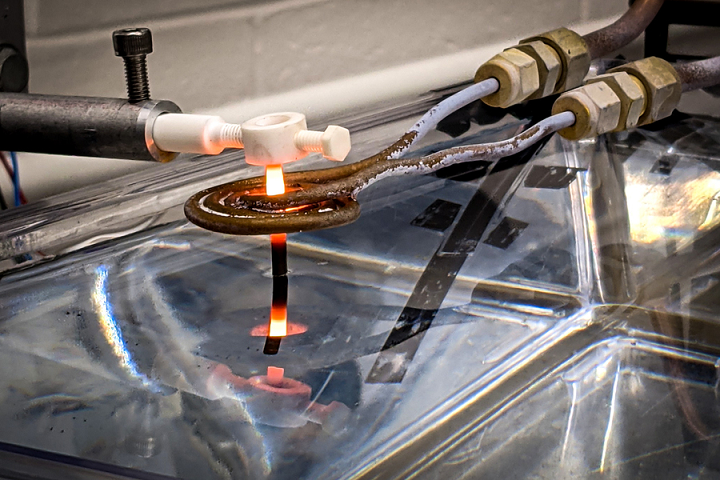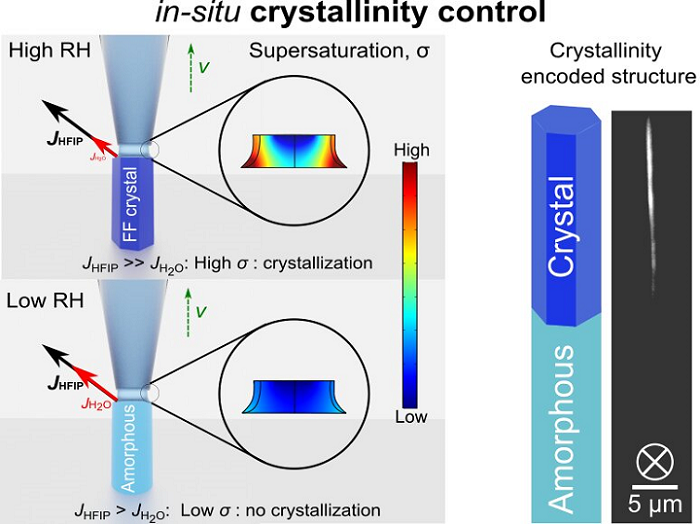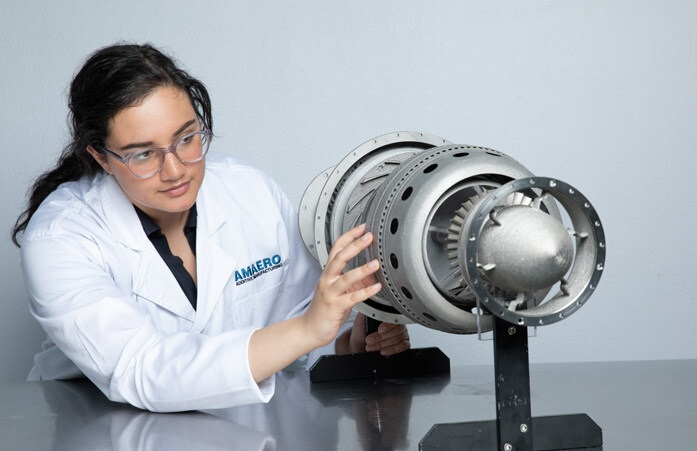In today’s 3D Printing News Briefs, Amaero International announced a partnership for 3D printing and powder production in Abu Dhabi, and a new heat treatment out of MIT enables the 3D printing of blades for gas turbines and jet engines. Researchers with the University of Hong Kong developed a new microscale 3D printer that can make multi-level anticounterfeiting labels. Finally, a new pavilion in Mexico City combined clay 3D printing with traditional architecture and paper craft.
Amaero International & Rabdan Industries Sign Binding JB Agreement
Australian metal 3D printing company Amaero International Limited (ASX:3DA) announced that it has signed a binding joint venture agreement (JV Agreement) with Rabdan Industries—an affiliate of diversified holding company Ethmar Holdings. Per the agreement, the companies will exclusively partner on additive manufacturing and metal powder production in Abu Dhabi, and FALCON Advanced Metals, the JV company, will be a 50/50 partnership between the two, operating as a holding company to control and own subsidiaries that will take on related projects. The JV will work to develop projects to vertically integrate the titanium supply chain, and both partners will contribute working capital on a pro-rata basis. The specific terms for each project will be laid out in separate SPV agreements, but the current project under consideration by the JV, with a capital budget of A$300 million, will include large-format 3D printing, large-scale metal powder production with seven gas atomizers, and more.
“After spending three months in the UAE and countless hours with our partners, I couldn’t be more excited about embarking on the next chapter of Amaero’s growth and development with Rabdan Industries,” said Hank Holland, Amaero’s Chairman and CEO. “Our partner brings deep knowledge and relationships in the UAE, as well as in the Kingdom of Saudi Arabia. Moreover, FALCON Advanced Metals’ capabilities and growth strategy closely align with the UAE’s priority economic and industrialisation initiatives.”
3D Printing Jet Engine & Gas Turbine Blades with MIT Heat Treatment
 A thin rod of 3D printed superalloy is drawn out of a water bath, and through an induction coil, where it is heated to temperatures that transform its microstructure, making the material more resilient. The new MIT heat treatment could be used to reinforce 3D printed gas turbine blades. Credit: Dominic David Peachey
A thin rod of 3D printed superalloy is drawn out of a water bath, and through an induction coil, where it is heated to temperatures that transform its microstructure, making the material more resilient. The new MIT heat treatment could be used to reinforce 3D printed gas turbine blades. Credit: Dominic David PeacheyResearchers at MIT came up with a new heat treatment process that can alter the surface of 3D printed metals, which makes them stronger and able to better withstand extreme conditions—perfect for high-stress applications such as blades for gas and wind turbines and jet engines. Typically, metal 3D printing causes tiny grains just tens or hundreds of microns across to form on the surface, which makes them susceptible to deformation, or creep, under mechanical stress or in high temperatures. But the MIT researchers were able to treat 3D printed metal components with a type of directional recrystallization, which is an old technique where metals are passed at precise speeds through very high temperatures. Once the temperature has been tuned to 1,235°C and the speed to 2.5 mm per hour, the tiny grains on 3D printed nickel superalloys were turned into larger, stronger columnar grains.
In addition to producing parts that can withstand high-stress applications, the MIT engineers said their new technique could also help in 3D printing more thermally efficient turbine architectures that use less fuel to produce the same amount of power. Additionally, MIT aeronautics professor Zachary Cordero said the research team hopes that in the future, jet engine manufacturers can use their process to 3D print and heat-treat components at large-scale AM plants.
Researchers Develop Microscale 3D Printer for Anticounterfeiting Labels
 3D printing process of polarization-encoded 3D micro-pixels. Credit: The University of Hong Kong
3D printing process of polarization-encoded 3D micro-pixels. Credit: The University of Hong KongAccording to a 2020 report issued by the United States Patent and Trademark Office (USPTO), the global value of pirated and counterfeit goods is between $1.7 and $4.5 trillion a year, and conventional approaches to anticounterfeiting, like QR codes, aren’t hard to fabricate because of limited data encryption capacity on a planar space. A team of researchers from the Department of Mechanical Engineering at the University of Hong Kong (HKU) is hoping to help with their new high-precision, microscale 3D printer that can produce new polarization-encoded 3D anticounterfeiting labels. The process uses the dipeptide species diphenylalanine (FF), which has unique properties like piezoelectricity and optical birefringence, for data encryption purposes, and can thus encrypt more digital information than traditional 2D labels are able to achieve. The team published their work in Nano Letters.
“Our new 3D printing method combined with nature-driven molecular self-assembly can print multi-segmented 3D FF micro-pixels with programmed crystallinity for high-density data encryption,” explained Dr. Ji Tae Kim, who led the HKU research team. “By utilizing different responses of the amorphous and crystalline segments to polarized light, a tiny single 3D pixel can encrypt a multi-digit binary code consisting of ‘0’ and ‘1.’ The information capacity can be increased to 211 with a single eleventh-segmented freestanding pixel on a tiny 4 µm2 area which is 1,000 times smaller than a hair strand.”
Pavilion Made with 3D Printing, Recycling, and Traditional Papercraft
 Interactive installation under the roof structure, featuring 3D printed clay blocks vaulted between beams as lost formwork. Image by Arturo Arrieta.
Interactive installation under the roof structure, featuring 3D printed clay blocks vaulted between beams as lost formwork. Image by Arturo Arrieta.The engineering team at Digital Structures MIT, together with international non-profit New Story, MANUFACTURA, and Mexico-based housing social enterprise Échale, developed a participatory, architectural installation, which featured in the Mextrópoli Architecture and City Festival. The site-responsive structure, called ‘Sueños con Fiber/Timber, Earth/Concrete,’ tells stories of the history of, and imagines new possibilities for, Mexico City, through the use of traditional papercraft, recycled wood, and 3D printed structural clay blocks that vault between concrete beams as lost formwork. The pavilion features a horizontal roof structure that starts with the existing joint and vault system and optimizes the shape of the precast reinforced concrete beams, using the 3D printed bricks, to decrease the amount of material usage.
Tepetate, a local soil with high clay content, has been used to construct housing communities around Mexico for over 30 years. For this project, it was used to 3D print compressed, sun-dried blocks for the pavilion wall in an affordable, low-carbon solution, reinterpreted with a post-tensioning system that allows for both assembly and disassembly. Computational design methods developed at MIT were used to sculpt the geometry of the outdoor pavilion, with the interactive installation underneath the horizontal clay roof structure.
Subscribe to Our Email Newsletter
Stay up-to-date on all the latest news from the 3D printing industry and receive information and offers from third party vendors.
Print Services
Upload your 3D Models and get them printed quickly and efficiently.
You May Also Like
Reinventing Reindustrialization: Why NAVWAR Project Manager Spencer Koroly Invented a Made-in-America 3D Printer
It has become virtually impossible to regularly follow additive manufacturing (AM) industry news and not stumble across the term “defense industrial base” (DIB), a concept encompassing all the many diverse...
Inside The Barnes Global Advisors’ Vision for a Stronger AM Ecosystem
As additive manufacturing (AM) continues to revolutionize the industrial landscape, Pittsburgh-based consultancy The Barnes Global Advisors (TBGA) is helping shape what that future looks like. As the largest independent AM...
Ruggedized: How USMC Innovation Officer Matt Pine Navigates 3D Printing in the Military
Disclaimer: Matt Pine’s views are not the views of the Department of Defense nor the U.S. Marine Corps Throughout this decade thus far, the military’s adoption of additive manufacturing (AM)...
U.S. Congress Calls Out 3D Printing in Proposal for Commercial Reserve Manufacturing Network
Last week, the U.S. House of Representatives’ Appropriations Committee moved the FY 2026 defense bill forward to the House floor. Included in the legislation is a $131 million proposal for...


































